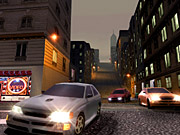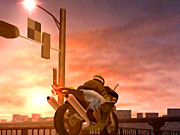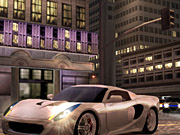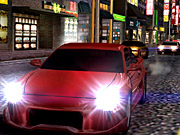Midnight Club II Designer Diary
Our latest look at the development of Midnight Club II focuses on the race design, shortcuts, and lighting in the cities.
Designing Races in an Open City
By Mauro Fiore
Lead Game Designer, Rockstar San Diego
The races in Midnight Club II are heavily influenced by real-life illegal street racing. Although most real street races are drag races where the competitors race a quarter mile or so in a straight line, some real races, like the midnight clubs in Japan, actually do longer races on highways. Let's not forget one of the most popular types of races in the world--trying to outrun the cops at all costs! In real street racing, racers follow each other to secret spots to battle it out, and you do the same thing in Midnight Club II. All these types of racing play a part in how the races in Midnight Club II are designed. We put these concepts into one illegal street racing game that has been exaggerated to make it fun to play.
What makes a race fun? I think a race is truly fun when it is close and you always feel like you have a chance to win. Once the map is learned, the main focus is getting through it faster and faster. It gets really fun when the challenge is laid out clearly and new things are regularly revealed at a pace to constantly keep the player excited about progressing further and further.

Creatively, open-city racing presents many development challenges. Perhaps the biggest challenge is to keep the sense of competition in a race where opponents can choose multiple paths. In Midnight Club II, you and your competitors will not take the same route every time. Designing a race needs to not only plan for this, but also take advantage of the freedom. The feeling of competition is key--we don't want the player to feel lost or frustrated. A well-designed race has checkpoints that allow the player to take multiple paths through the city to win (via shortcuts, jumps, and so on) while creating lots of opportunities for opponents to race wheel-to-wheel or meet head-on as different paths cross from opposite directions. To take into account all these variables and have a race that is consistently fun takes a lot of creativity and testing.

With an open-city plan, racers need to become familiar with the city map so they can make split-second decisions on what route to take based on conditions like ambient traffic, police, and other competitors' paths. This is much different than a track-based racer, where the environment stays the same and racers learn the track through repeated laps. Also, the shortcuts in track racers feel like shortcuts--in an open city, shortcuts just seem like natural paths of the city, so the continuity isn't broken. The race designer's job is to use the city to make races that are consistently fun while taking into account the unpredictable elements that come into play.
Because Midnight Club II is set in open cities, people are bound to have their favorite routes and find their own sequences of jumps and shortcuts they want to race through. So we added a race editor to the game, which allows you to choose where the checkpoints are placed in the city and then challenge the computer, your friends, or people from across the globe via online play.
Beyond the Streets - Shortcuts and Secrets
By Mauro Fiore
Lead Game Designer, Rockstar San Diego
For many gamers, the original Midnight Club was the first time they'd ever experienced the freedom to take any route in a racing game. One of the things they loved were the shortcuts. We learned that the more options a racer has the better, so when beginning Midnight Club II we knew that shortcuts and hidden routes needed to be an even bigger element. It's all about freedom and fun--we wanted to keep up the adrenaline rush throughout the race. In my opinion, this means being able to do things like launching off a massive jump that sends you over a building, dropping off a highway overpass, and making a split-second decision to hit a tight alleyway that you have spotted. So our goal when designing the shortcuts in the cities in Midnight Club II was not only to add more shortcuts, but also to enhance the racing by stretching reality--big air, breakable objects and interiors, hidden tunnels--with things that don't exist in the real-life cities. At the same time, we wanted to take advantage of the views and real-life landmarks to make the experience that much more memorable.
Key elements are placed throughout the cities to maximize the racing experience. For example, an alleyway shortcut could lead to a ramp that takes you up to a huge jump to a rooftop, which you can then turbo off across the river, with a view of the entire city below you, only to land on a river barge, which has another ramp, sending you off onto the street, driving straight through the glass of a building. The key is that there isn't only one fun route through the city, there are many routes, each filled with unpredictable sequences of shortcuts and obstacles to keep the action fast-paced. A track-based racing game gets predictable very quickly, because you are on a repeating track and everyone is racing in one direction. In Midnight Club II, there is no track and the racing can be complete mayhem, with competitors going in all directions. So the player needs to not only learn the city, but also to be able to respond quickly to opportunities to save time.

Finding shortcuts requires exploration, keeping your eyes open for things like breakable glass and destructible barriers on highway overpasses. The player should also pay close attention to his or her opponents--they will use different shortcuts and tricks. They won't do the same thing twice, but they will reveal aspects of the city to you. Also, take a moment to study the big map. You will be able to quickly identify patterns in the checkpoint layout that will hint at possible optimal routes.
Progressing through the game, you will find that the cities are incredibly multilayered--races can take you from underground tunnels, up to the streets, to a huge jump that lands you on top of a tall building, and then back down to drive through a mall. When we talk about shortcuts, we are not talking about just hidden alleyways. The player needs to have skills and sophistication, in addition to knowledge of the city.
Without getting too detailed, here are a couple of hints on where to find a few of my favorite shortcuts: In Los Angeles, race through the California Plaza to a huge jump in downtown, which lands you on a bridge and into the construction yard. In Paris, drive up the Pompidou Center escalator, jump out through the windows, land on rooftops, and then drop over the Seine River to Notre Dame. In Tokyo, fall off train tracks onto the small island and then launch off the ramp over the bay.
Lighting
By David Hong
Art Director, Rockstar San Diego
Our lighting philosophy has always been to balance realism with gameplay clarity. It is important when designing the lighting to create an atmosphere that accurately represents the real city. But at the same time we use light and contrast strategically to enhance the player's experience and lead him or her visually to a shortcut or an important route.

For Midnight Club II, our philosophy was to use lighting to create the overall mood of the city and define the characteristics of each neighborhood. LA is warm and bright, Paris is dark and gloomy, and Tokyo is electric and full of neon and fluorescents. Getting more detailed, there are enough lighting differences from one neighborhood to another to give players enough information about what part of city they are driving in without having to look at the map all the time. For example, driving in the Watts area of LA should feel different from driving in Santa Monica, which should feel different from Hollywood. Lighting plays a very important role in this, because we are creating distinct vibes that need to be recognizable at high speeds. Many times players will not be able to make out detailed signs, so the lighting will direct them.
Very early in the development, we begin by roughly defining the mood and possible color and lighting schemes for each of our cities. I work closely with our game designer and creative director to come up with color keys and inspirational color works. Midnight Club II has three different times of day (dusk, midnight, and dawn) and three different weather conditions (clear, rain, and fog) in each of its three cities, for a total of 27 different lighting schemes. We create color comps for each city to use as a guideline for this massive lighting project. This whole previsualization is essential for each element of the scene to work.
Lighting a city is a three-layered process in Midnight Club II. First, the basic patterns of streetlights and traffic lights are laid out, along with the sky texture for each time of day. This is then processed by a custom radiosity lighting tool that takes into account the color, brightness, and positions of all the lights (including the sky) and stores color information for the entire city. Finally, this foundation is built upon by adding lights to windows, doorways, signs, building tops, alleys, and so on. All the lights are then fine-tuned to brighten or dim certain areas.

There are two main types of lighting in the cities of Midnight Club II: global illumination and direct illumination. Global illumination is calculated offline with a custom tool. This is a technique that calculates the combined effect of all the light sources in a city on each surface. The light sources in the city are diverse: There is ambient light from the sky; individual point lights on streetlights, buildings, storefronts, and neon signs; and more. The global illumination process is very time-consuming. It took a year of development to calculate how to manage the lighting, considering memory limitations--I mean, there are more than 15,000 individual lights per city, and the whole city is always open. Direct illumination is used to light dynamic objects, such as vehicles, props, and pedestrians, and it is a more traditional method of simply lighting a surface directly from a light source. This way, as the dynamic objects move, the lighting changes accordingly. For example, when ambient cars drive in front of you, their headlights affect the lighting in that area.
Overall, this has been by far the most intensive lighting process that Rockstar San Diego has ever undertaken. As far as I know, no other game has as many lights as Midnight Club II. The technical lighting issues that we have hammered out over the last two and a half years are something that we feel have truly pushed gaming forward.
Got a news tip or want to contact us directly? Email news@gamespot.com
Join the conversation